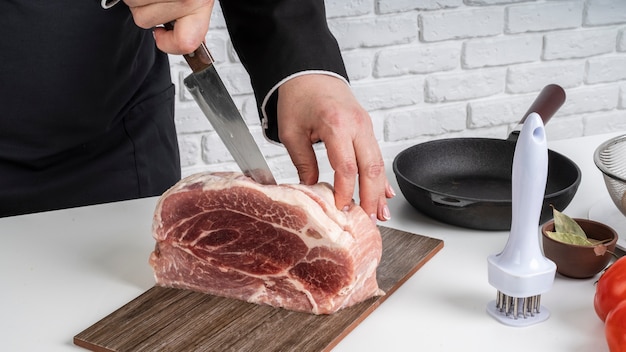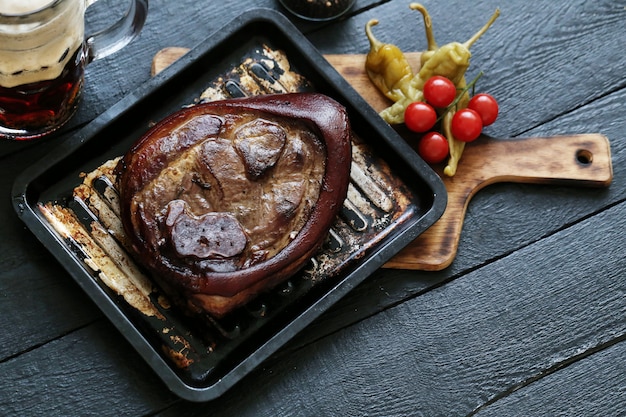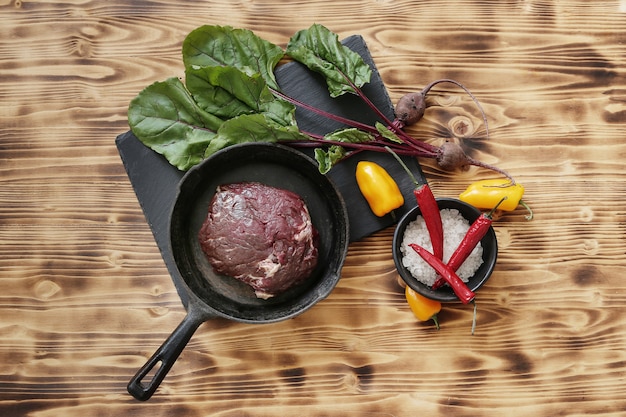There's something undeniably satisfying about a perfectly cooked pork sirloin chop. That crisp, golden-brown crust giving way to tender, juicy meat, bursting with flavour – it's a culinary symphony! But, we've all been there, haven't we? The disappointment of a dry, overcooked chop that just doesn't live up to the promise. Let's face it, those dry, tough pork chops can be a real culinary downer. But, fear not, fellow food enthusiast! I'm here to share some hard-earned wisdom and simple techniques that will transform your pork chops from ordinary to extraordinary, making them a star attraction on any table. So grab a cuppa, settle in, and let's embark on this culinary adventure together.
Part 1: Choosing the Right Chop

You know the saying, "You can't make a silk purse out of a sow's ear"? Well, it's true for pork chops too. Starting with a quality piece of meat is the foundation of a delicious dish. You've got two main choices: bone-in or boneless. Personally, I'm a bone-in kind of guy. They offer a deeper flavour and tend to stay juicier because the bone helps retain moisture, almost like a built-in roasting rack. But hey, culinary preferences are like fingerprints - unique to each individual. Go with what tickles your fancy.
Choosing the Right Thickness
Think of thickness like choosing the right gear for your bike. A thin chop, around 1 inch thick, is great for a quick, easy dinner. They're perfect for pan-frying, delivering that satisfying sizzle and browning in a jiffy. However, if you're after something more substantial, a thicker chop, around 1.5 inches thick, is the way to go. You'll need a bit more time, but trust me, the payoff is worth it. The extra time allows the heat to penetrate the meat evenly, resulting in a tender, juicy, and undeniably more satisfying experience.
Checking the Fat Marbling
Now, let's talk about fat. I know, I know, some folks are wary of fat, but it's actually your friend in the pork chop world. Think of fat as the secret sauce that makes your pork chop sing. Look for a good amount of marbling running through the meat. This fat will render during cooking, basting the meat and adding incredible flavour and moisture. It's like having a built-in self-basting system! A bit of white fat on the surface is fine, but avoid those with thick layers of fat, you don't want your chop swimming in grease, do you?
Part 2: Preparing the Chops

You've got your chosen champion, now it's time to prep them for the spotlight! It's all about setting the stage for culinary greatness. Don't worry, this isn't complicated, but it's essential to unlock the full potential of your pork chops.
Patting them Dry
First, give those chops a good pat down with paper towels. It's like getting rid of any unnecessary distractions, you want the meat to focus on browning, not steaming. Excess moisture can hinder browning, leading to a soggy, less flavorful result. We want a beautiful, crispy, golden-brown crust, right?
Seasoning Like a Pro
Alright, time for the flavour explosion! This is where you get to unleash your creativity. I like to keep it simple and let the natural pork flavour take center stage. A generous sprinkle of salt and pepper is my go-to, and sometimes I add a pinch of paprika for a touch of colour and smoky goodness. But, the beauty of cooking is experimentation! Feel free to get creative with your spice game. Garlic powder, onion powder, herbs, a blend of your favorite spices – the possibilities are endless! Just remember, season generously, and don't forget to hit those edges. Those little bits of flavour are like secret surprises.
Adding a Marinade (Optional)
This is a bit of a personal preference. Some folks are all about marinades, and I don't blame them. I find that a good marinade can tenderize the meat and infuse it with an incredible flavour profile. If you're feeling adventurous, a simple mix of olive oil, lemon juice, and herbs can work wonders. Let your chops soak for at least 30 minutes, or even better, overnight. It's like giving them a mini spa treatment! Just remember to pat them dry again before cooking.
Part 3: Choosing the Cooking Method

Now, here's where things get interesting! There are countless ways to cook a pork chop, from the simple to the sophisticated. I'll guide you through the most popular and effective methods, ensuring you find the perfect fit for your culinary style and occasion.
Pan-Frying
This is my go-to for weeknight dinners, a classic technique that delivers a satisfying sizzle and a beautiful, golden-brown crust. It's ideal for those thinner chops. Simply heat a pan over medium-high heat, add a bit of oil – I love a good olive oil – and sear those chops for 3-4 minutes per side for medium-rare. Keep a close eye on them, adjust the heat as needed, and don't be afraid to give them a little nudge to ensure even browning.
Grilling
Ah, the grill! There's a certain magic to cooking over an open flame, a smoky, chargrilled flavour that takes your pork chop to a whole new level. If you're venturing into the world of grilling, make sure your grill is nice and hot. Give those grates a good scrub with a grill brush – you want a clean canvas for your culinary masterpiece. Cook your chops for about 4-5 minutes per side for medium-rare, flipping them once. And remember, a meat thermometer is your best friend, ensuring your chops are cooked to perfection.
Baking
Baking is a great option when you're looking for a hands-off approach. It's also ideal for cooking a larger batch of chops. Preheat your oven to 375°F (190°C), place your chops on a baking sheet, and cook for about 20-25 minutes, or until they reach an internal temperature of 145°F (63°C). You can even add some vegetables to the baking sheet for a delicious one-pan meal.
slow cooking
The slow cooker, a culinary hero for busy weeknights! Simply throw your chops in with some sauce, vegetables, and spices, and let it simmer away. It's the perfect way to cook those thicker chops, resulting in incredibly tender and juicy meat. For slow cooking, I recommend using a low heat setting for 6-8 hours, or a high heat setting for 3-4 hours. Just make sure to check the internal temperature before serving.
Part 4: Knowing When It's Done
The anticipation is building, your pork chops are sizzling away, and you're just about ready to dig in! But before you declare victory, it's crucial to ensure they're cooked to perfection.
Using a Meat Thermometer
This is the most reliable way to gauge doneness. A meat thermometer is like a culinary compass, guiding you towards that sweet spot of juicy perfection. Insert it into the thickest part of the chop, making sure it doesn't touch the bone. The internal temperature should reach 145°F (63°C) for medium-rare. If you prefer a bit more well-done, cook it to 155°F (68°C).
The "Finger Test" (Not for the Faint of Heart)
Now, this one is a bit of a gamble, but some folks swear by it. It's called the "finger test." Press gently on the center of the chop. If it feels firm and springy, it's done. If it feels soft and jiggly, it needs more cooking. But, this method is less accurate than using a thermometer.
The "Color Change" (Less Reliable)
This is the least reliable method. The color of the meat can vary depending on the cut and the cooking method. A pink hue doesn't mean the meat is undercooked, and a browned exterior doesn't guarantee it's cooked through. So, rely on your thermometer for accurate results.
Part 5: Resting Time
Alright, your pork chops are cooked to perfection! But before you start slicing, give them a little rest, about 5-10 minutes. This allows the juices to redistribute throughout the meat, ensuring a more succulent and tender bite. It's like giving them a moment to catch their breath before they become the star of your dinner plate.
Part 6: Adding Those Final Touches
Your pork chops are cooked, rested, and ready for their grand entrance! But let's not forget those finishing touches that can elevate your dish from delicious to divine.
Adding Sauce
A good sauce can add depth and complexity to your pork chops. I like to keep it simple, making a pan sauce from the drippings. Just add a splash of wine or broth to the pan and scrape up all the delicious bits. Let it simmer for a few minutes until it thickens, and you've got a sauce bursting with flavor. If you're feeling adventurous, try a creamy mushroom sauce, a tangy apple cider sauce, or even a sweet and savory cranberry sauce.
Adding Garnishes
Garnishes are like the final flourish on a masterpiece, adding visual appeal and a touch of freshness. For pork chops, I love to sprinkle fresh herbs, like parsley or chives, or add a few slices of lemon for a bright citrusy touch. You can also get creative with roasted vegetables, a dollop of sour cream, or even a sprinkle of toasted nuts.
Part 7: Serving Up Your Masterpiece
The grand finale! Your pork chops are ready to take center stage. Present them proudly on a plate, adorned with your chosen sauce and garnishes. Take a moment to appreciate the beautiful, golden-brown crust and the succulent, juicy meat. It's a testament to your culinary skills!
Part 8: Serving Suggestions
Pork sirloin chops are incredibly versatile, pairable with a vast array of sides. Here are a few ideas to spark your culinary imagination:
Starchy Sides
These provide a comforting base for your pork chops:
- mashed potatoes – classic comfort food
- Roasted potatoes – crispy, flavorful, and perfect for soaking up pan sauce
- sweet potato fries – a sweet and savory counterpoint to the savory pork
- rice pilaf – a light and fluffy addition
- Couscous – a versatile option that can be flavored with herbs and spices
Green Sides
These add a touch of freshness and balance to your dish:
- green beans – a classic, versatile side
- Asparagus – a light and elegant accompaniment
- Broccoli – a nutritious and flavorful choice
- spinach salad – a fresh and vibrant addition
- roasted brussels sprouts – a surprisingly delicious and hearty option
Other Sides
Get creative and explore beyond the ordinary:
- Apple sauce – a sweet and tart classic
- Cranberry sauce – a tangy and festive choice
- Peach chutney – a sweet and spicy twist
- A simple salad – a refreshing counterpoint to the rich pork
- Bread rolls – perfect for soaking up sauce and drippings
Part 9: Storing Leftovers
Leftover pork chops? Don't let them go to waste! They're perfect for using in other dishes. Store them in an airtight container in the fridge for up to 3-4 days. Try them in salads, sandwiches, or soups – the possibilities are endless!
FAQs
Let's address some frequently asked questions about cooking pork sirloin chops.
1. How long should I cook pork sirloin chops for?
The cooking time will vary depending on the thickness of the chops and your preferred level of doneness. A general rule of thumb is about 3-4 minutes per side for thin chops (around 1 inch thick) and 4-5 minutes per side for thicker chops (around 1.5 inches thick). Always use a meat thermometer to ensure the internal temperature reaches 145°F (63°C) for medium-rare.
2. What are the best spices to use for pork sirloin chops?
The beauty of pork sirloin chops is that they can be seasoned with a variety of spices and herbs. A simple combination of salt and pepper is always a winner. You can also experiment with other spices like garlic powder, onion powder, paprika, oregano, rosemary, thyme, and chili powder. Get creative and find your own perfect blend!
3. Can I freeze pork sirloin chops?
Absolutely! Freezing pork sirloin chops is a great way to extend their shelf life. Wrap them tightly in plastic wrap or aluminum foil, then place them in a freezer-safe bag. They can be frozen for up to 3-4 months. When ready to use, thaw them in the refrigerator overnight before cooking. Just be aware that the texture of the meat might be slightly different after freezing and thawing.
4. What are some good substitutes for pork sirloin chops?
If you can't find pork sirloin chops, there are a few good substitutes, like pork tenderloin, pork loin, or even chicken breasts. Just be mindful of the cooking times and adjust the recipe accordingly.
5. What are some tips for making juicy pork sirloin chops?
Here are a few tips for achieving juicy pork sirloin chops:
- Don't overcook them! overcooked pork chops will be dry and tough. Cook them to an internal temperature of 145°F (63°C) for medium-rare.
- Choose chops with good fat marbling. The fat will baste the meat as it cooks, keeping it moist and flavorful.
- Let them rest for a few minutes after cooking. This allows the juices to redistribute throughout the meat, resulting in a more succulent bite.
- Don't overcrowd the pan. This will prevent the chops from browning properly and will cause them to steam instead of sear.
Now you're armed with the knowledge and skills to conquer the world of pork sirloin chops! So, go forth and create culinary masterpieces that will leave your taste buds singing. Happy cooking!
Everyone is watching

Corn on the Cob: The Ultimate Guide to Perfectly Cooked Ears
Healthy MealsAh, corn on the cob. Just the name evokes images of sunny days, barbecues, and that sweet, juicy flavour that ...

Perfect Pork Roast Oven Cooking Time: A Guide to Delicious Results
Healthy MealsThere's something truly satisfying about a perfectly roasted pork. The aroma alone is enough to make your mout...

Ham Cooking Time: How Long to Bake, Smoke, or Boil a Delicious Ham
Healthy MealsAh, ham. It's a classic, isn't it? A real crowd-pleaser, especially around holidays. And when done right, it'...

Scallops: The Ultimate Guide to Perfect Cooking
Healthy MealsAh, scallops. Those delicate, sweet, and utterly delicious morsels of the sea. They hold a special place in my...

Spaghetti Squash: The Ultimate Guide to Cooking and Serving
Healthy MealsRemember that time you saw spaghetti squash at the supermarket, looking all bumpy and strange, and thought, "W...
